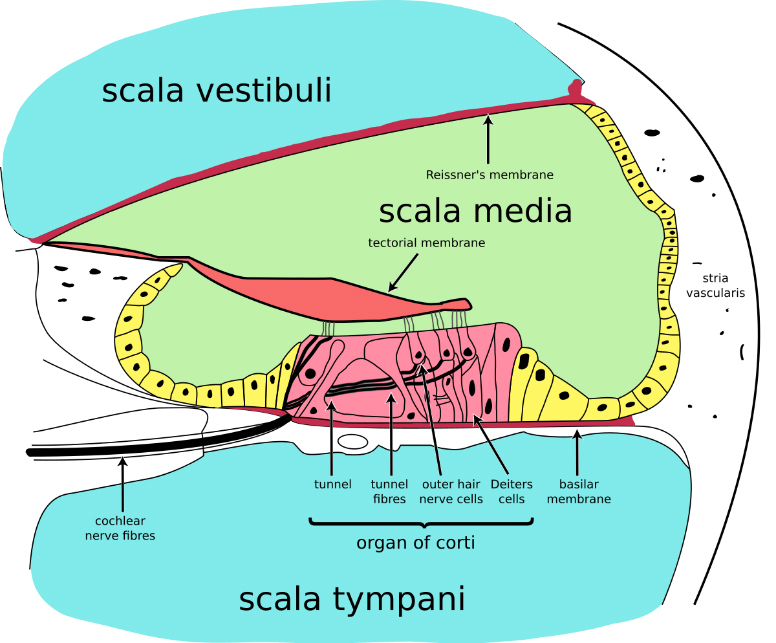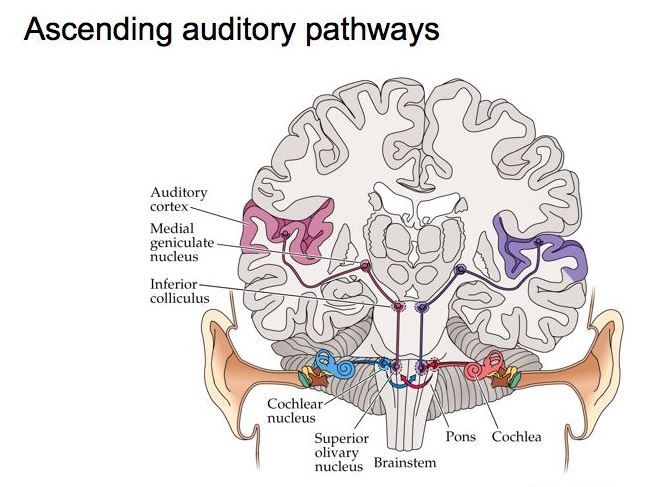4.1.9 What does the Inner Ear do?

The inner ear transforms vibratory energy into an electro–chemical signal recognizable to the brain.
The cochlea receives the sound signal and relays it to the brain, via the auditory nerve. It converts vibratory sound waves into the electrochemical signals, which can be interpreted by the brain.
The ear de-codes sound vibrations, giving an extraordinarily complex description to the brain of all auditory input received. The whole internal mechanism of the human ear would fit into a match box, yet it can apprehend sounds as subtle as a pin dropping or as loud as a clap of thunder overhead. No manufactured device can come dose to the fidelity of the human ear.

The ear is the only primary sense organ which is registered at all three levels of the brain. These are:
The Medulla reptilian state
The Mesencephalon mid brain– animal state
The Cortex human state
Diseases of perception are often due to a malfunction in the lower levels of the brain. The visual sense is seated only in the cortex. Therefore perceptual problems often need to be addressed through the auditory function
As the vibrations travel through the cochlea they cause movement in the hearing organ within the scala media.
The inner ear is rich in sensory nerve fibres which send sound signals to the brain. However, it also includes motor neurons which are receiving instruction from the brain and directing the inner ear on how to perform.
For example, the amplification of soft sounds by the outer hair cells involves these cells being activated by motor nerve pathways. This is called the ‘active process’ in the cochlea and is part of what gives us our remarkably sensitive and flexible hearing ability.
The cochlea emits very subtle waves from this active process and these can be measured by audiologists. The emissions from the cochlea are called otoacoustic emissions or OAE. This test helps the audiologist to determine if the inner ear is working normally and therefore to ascertain if a hearing problem is related to the inner ear or the brainstem. It is one of the tests done in newborn hearing screening to determine if a newborn baby has normal hearing.


Thus we come to understand that the inner ear is a processing centre of great subtlety and complexity, processing, tuning and reformulating sound waves in such a way that they will be useful and decipherable by the brain.
The auditory pathways between the inner ear and the brain are highly complex, travelling up through three levels of the brain and continuing to process and interpret sounds as they progress from sensory reception to conscious perception.
The Medulla contains the ventral cochlear nucleus, which contributes to vertical spectral analysis (i e were the sounds coming from above or below us).
In the Pons we have the Super Olivary Complex which assists more with spatial analysis of horizontal directional perception and also with temporal analysis (i e the timing and rhythm of the sound.)
In the mid brain, the inferior colliculus integrates all of the information gathered so far, including tonal spectrum, vertical and horizontal directionality.
Finally the sound signal is ready to enter the auditory cortex where the final analysis takes place.
In the core of the auditory cortex is the tonotopic analaysis, which detects the frequency of (pitch) of the sound signal it receives.
![auditory_pathway[1]](https://soundtherapysynergy.com/wp-content/uploads/auditory_pathway1.jpg)

The secondary cortex, which is the peripheral region, is a more diffuse area that integrates sound information into other sensory and motor systems of the body.
The auditory cortex links to many other parts of the brain, in the limbic and cortical areas, so that sound now comes into the light of consciousness, and meaning is attributed to the signals being received.
From this greater perspective we see that the inner ear is in constant communication with the auditory centres in the brain so that the two way flow of information results in a highly tuned and appropriate sound signal to finally reach our consciousness.

